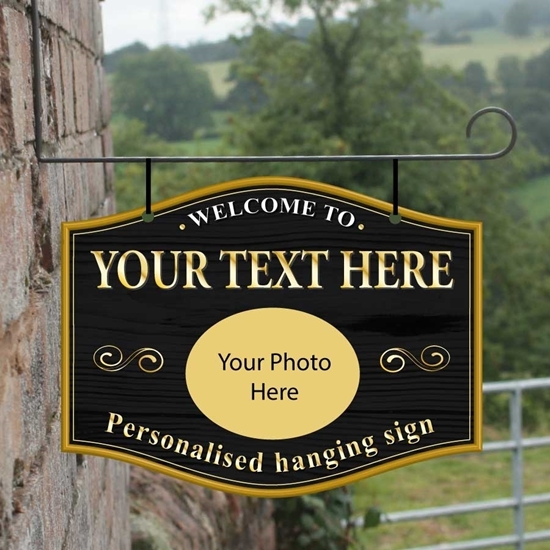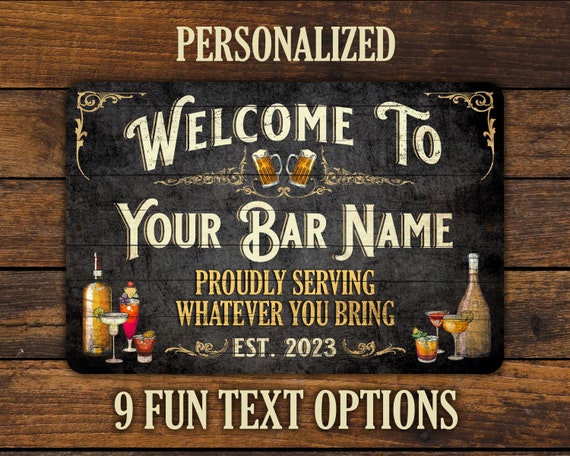Excellent Facts For Selecting Man Cave Signs
Excellent Facts For Selecting Man Cave Signs
Blog Article
What Is The Difference Between Bar Signs In Relation To Location?
The location is an important factor when it comes to bar signs. The design, function and positioning are all crafted to increase their efficiency. Below is a breakdown of the ways bar signs differ based on the location they are placed in: 1. Exterior Signs
Purpose: To attract customers from outside and establish the bar's brand identity.
Highlights: Big, attractive features, usually illuminated to improve illumination at night.
Materials: Materials like metals, neon, LEDs and weather-resistant vinyl.
Signs above the entrance Bar's name, logo, marquee, etc.
2. Entrance Signs
We welcome customers to the store and provide basic information.
Often with branding elements, the features are clear and inviting.
Materials: metal, wood or illuminated sign.
Examples "Welcome to the store" signs and operating hours, or announcements about special events.
3. Interior wall signs
The purpose of the sign is to add style, convey information and create a sense of place.
Features: Various in size and design to match interior decor.
Materials: Wood, metal, chalkboard, acrylic.
You can also utilize inspiring quotes or menu boards.
4. Behind-the-Bar Signs
Objective: To emphasize key elements like the bar's name, signature drinks, or specials.
Features: Well-lit and prominent, it serves as a focal point.
Materials: Digital displays such as chalkboards, neon, chalkboards or LED displays.
Examples include bar name signs and boards with drink specials.
5. Ceiling and hanging signs
The purpose of this is to provide direction information or to enhance the décor from above.
Features: Suspended to the ceiling. Viewable from all angles.
Materials These are lightweight materials, such as foamboard, acrylic or even metal.
Examples: Directional arrows decorative hanging signs and themed props.
6. Tabletop Signs
Purpose : To inform patrons of the specific details about their table.
Features: The font is tiny and easy to read close.
Materials: Wood, laminated papers, and acrylic.
Examples include drink menus, table numbers, promotional cards, and QR code stands.
7. Restroom Signs
Use: To determine the location of restrooms.
Features: Highly visible with clear and often clear symbols as well as the text.
Materials: Metal, plastic, wood.
For instance, there are men's and women’s restroom signs.
8. Directions and signs
The purpose of this sign is to guide patrons towards different areas in the bar.
Easily readable labels and arrows.
Materials: Metal, acrylic, wood.
For example, signs pointing toward restrooms or exits.
9. Window Signs
Objective: To draw the attention of passers-by, and to provide information about the bar.
Highlights: Easily visible outside, often with lighting.
Materials: Vinyl decals, neon, LED.
Examples: advertisements, promotions, event announcements and hours of operation.
10. Signs for Promotion and Event
Purpose : To inform customers of seasonal or exclusive deals or events.
Features: Attractive and sometimes temporary.
Materials: Vinyl, foamboard, chalkboard.
Event posters can be used banners to promote events or chalkboards for promoting special events.
Local Specific Considerations
Visibility
Signs for entry and exterior signs have to be extremely noticeable.
Signs for the interior and behind the bar: They must be strategically placed to maximize impact and ease for reading.
Durability
Exterior Signs. Materials must be weatherproof.
Interior signs - They can be made of a wide selection of materials as they are protected from weather.
Aesthetic Integration
Signs with decorative designs and bar signposts behind must be in keeping with your interior theme.
Informational and Directional Signs: Must be functional, but still blend in with the decor.
Functionality
Signs for restrooms and directions The signs should be easy to read and clear enough to enable patrons to navigate the area with ease.
Promotional and Event Signs are able to be altered or temporary to reflect the current products.
Lighting
Exterior and window Signs The majority of them are lit to improve visibility at nights.
Interior and Behind the Bar Signs: Use lighting to create ambience or highlight specific areas.
Bar patrons can create a welcoming atmosphere by customizing the design of their bar, the material and layout of bar signs. Have a look at the top rated make a pub sign for website advice including personalised garden bar signs, personalised signs for home bar, pub wall sign, large personalised bar signs, garden bar signs, make a pub sign, cocktail bar sign, hanging home bar signs, to the pub sign, bar signs for home bar and more.
How Do Bar Signs Differ In Light?
Bar signs differ in their lighting. This impacts visibility, ambience and even impact. Here are some of the ways that bar sign lighting may be affected Neon signs
Characteristics: Bright, colorful, classic.
Lighting Neon gas-filled tubes release lights when charged electrically.
Uses: Create an old-fashioned style with this material. It is frequently employed to create logos, barnames and other eye-catching designs.
The nostalgic appeal and high visibility make this a fantastic option.
The material is delicate and expensive to fix.
2. LED Signs
Characteristics: Energy-efficient, versatile, modern.
Lighting: Light-emitting Diodes (LEDs) create a bright, vibrant and luminous light.
Uses: Ideal for outdoor and indoor signs, displays that can be programmed and dynamic lighting effects.
Benefits: LEDs are durable, efficient in energy use, and can be programmed to show animations or changes in color.
Disadvantages include initial cost, however, it is cheaper to pay for energy and maintenance bills.
3. Backlit Signs
Characteristics: Elegant, sophisticated, subtle.
Lighting: A translucent surface is illuminated with LEDs or fluoro lights to produce an ethereal glow.
Applications: Typically used on modern bar signs, menu boards, and branding elements.
Benefits: Professional and clean appearance, improves readability at low lighting.
Advantages: More complicated installation and a higher initial cost.
4. Signs for Edge-Lit
Characteristics: Sleek, contemporary, stylish.
Lighting Use LEDs to highlight the edges of a sign, typically acrylic.
Applications: Ideal for contemporary, minimalistic styles.
Advantages: Gives your home a distinct and sophisticated appearance, as well as energy-efficient.
Advantages: Only available in certain style of design.
5. Ambient/Accent Lighting
Characteristics: Subtle, atmospheric, decorative.
Lighting: Utilizes indirect sources of light to emphasize and highlight signs.
Applications for this product The product can be used to enhance the ambience and is frequently used to emphasize themes in decor or art.
Benefits: It adds an atmosphere and depth. It can create a welcoming and cozy environment.
Negatives
6. Marquee signs
Characteristics: Bold, theatrical, eye-catching.
Lighting: Use multiple lights or LEDs along the edge of the sign.
Uses: Popular as outdoor signs, for event promotions and to give a vintage look.
Benefits: Increased visibility and attention grabbing.
Negatives: Costly and requires frequent maintenance.
7. Projection Signs
Characteristics: Dynamic, innovative, versatile.
Lighting: Make use of projectors to cast light and images onto the surface.
Applications include: promotions, events Dynamic displays, temporary promotions.
Simple to modify No need for physical signs.
Disadvantages
8. Fluorescent Signs
Characteristics: Bright, cost-effective, traditional.
Lighting Tubes that emit light for lighting.
Uses: Typically used on larger indoor and outdoor signs.
Advantages: Bright, effective and affordable for large-scale signs.
Advantages
Lighting Things to Consider
Visibility
Neon and LED signs: Great for grabbing your attention from the distance.
Backlit and edge lit signs are excellent for improving the readability as well as creating a professional appearance.
Energy Efficiency
LED signs are energy efficient and last for for a long time.
The neon and fluorescent signs are less efficient in energy use, with neon being more fragile.
Aesthetic Appeal
Neon and Marquee Signs: Ideal for retro and vintage aesthetics.
The ideal option for clean and modern designs are edge-lit signs with backlighting.
Ambient Lighting: Creates an inviting and relaxing environment.
Maintenance
LED Signs are low maintenance and durable
The neon and fluorescent signs could require more frequent maintenance and repairs.
Cost
Backlit and LED signs Backlit and LED signs: higher upfront costs but lower operational costs.
Fluorescent signs are less expensive initially, but they use more energy in the long term.
Flexibility
Projection and Programmable Signs Flexible display options for changing displays and dynamic content.
Traditional Signs - More rigid, but can often give an desired appearance.
Choose the right type lighting for your bar signs to enhance visibility, create a welcoming environment, and effectively promote your brand's message and promotional messages. Read the top home pub signs tips for more info including personalised home pub sign, hanging home bar signs, buy bar signs, large bar signs, pub signs, signs for garden bar, hanging pub signs personalised, bar hanging sign, pub sign design ideas, personalised outdoor bar signs and more.
What Is The Difference Between Bar Signs In Terms Of Interactivity?
There are different levels of interactivity that can be used on bar signs to enhance customer engagement and experience. Below are the distinctions between bar signs in terms of their interactive capabilities. Static Signs
Static Signs: They are static signs that communicate information but do not include any interactive components.
Common Types: Printed poster or painted murals as well as traditional neon signs.
2. Digital Displays
Digital Signs can be used to display multimedia content and real-time animations.
Interactivity: Touchscreens can provide interactive menus, games, or even promotional content.
Benefits: Attract attention, provide dynamic information and encourage the participation of patrons.
3. QR Codes
QR Codes on signs The QR codes on signage can be used to connect to menus, promotions, or social media profiles.
Benefits : Make it simple to access more information, promotions, or loyalty programmes.
4. LED Screens
LED screens can display animated text, video and animations.
Touch-enabled, LED screens let patrons interact with content like choosing menu items or playing games.
Benefits include: Getting the attention of others through creating experiences that are immersive.
5. Projection Mapping
Immersive Experiences Projection mapping transforms the surface into dynamic displays, offering interactive visuals and storytelling.
Interactivity: Guests can interact with interactive elements like games or virtual experiences.
Benefits: Create unforgettable experiences, increase ambience, and increase social interaction.
6. Augmented Reality
AR enhances the reality by overlaying digital media onto the physical environment. This allows for interactive experiences.
An AR-enabled sign lets customers interact with digital components such as viewing recipes for cocktails or virtual games.
Benefits: Engage customers and provide unique experiences to make your bar stand out.
7. Motion Sensors
Motion sensors can be used to detect movement within signage and trigger interactive responses.
Interactivity - Signs respond by changing their content or displaying animations, as well as displaying specific messages in response the patron's actions.
Benefits include: increasing participation, creating a more immersive environment and enthralling patrons with unexpected and exciting experiences.
8. Social Media Integration
Online Interaction Signs - Posters featuring hashtags or social media handles urge users to participate online.
User-Generated Content: Encourage patrons on social media to share pictures of bar signs, extending their reach and showcasing their work.
Benefits: Encourage participation in the community, improve the visibility of your brand, and also create content created by the users.
9. Interactive Lighting
Dynamic Effects: LED or neon signs equipped with interactive lighting respond to sounds, touch or motion.
Signs can be interactive by changing brightness, color or pattern based on the interaction of patrons or environmental cues.
Benefits Create immersive atmospheres and increase ambiance. Draw attention.
10. Gamification
Interactive Games: The signs include interactive games or challenges to keep the crowd entertained and inspire participation.
Reward: Offer discounts or other rewards to players who complete challenges or win games.
The benefits include: extending time spent in the room, fostering social interaction, and enabling repeat visits.
By adding interactive elements to signage, bar owners create experiences that entice patrons to increase brand awareness and differentiate their establishment from others in the market. Check out the recommended her comment is here for window vinyl for site tips including outdoor home bar signs, home bar pub signs, personalised cocktail bar sign, bar sign hanging, bar sign outdoor, outdoor personalised bar sign, hanging bar sign, make your own bar sign, hanging bar sign, the staying inn pub sign and more.